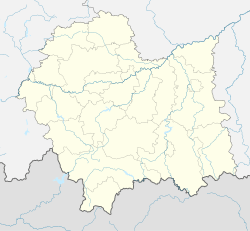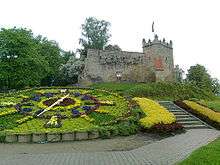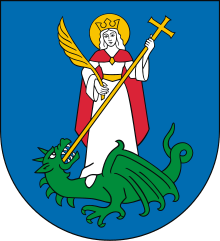Nowy Sącz
Nowy Sącz (Polish pronunciation: [ˈnɔvɨ ˈsɔnt͡ʂ]; Hungarian: Újszandec) is a city in the Lesser Poland Voivodeship of southern Poland. It is the district capital of Nowy Sącz County as a separate administrative unit. Founded by the Duke of Kraków on 8 November 1292, New Sacz (known also by other names) is one of the oldest cities in the Lesser Poland region, with a population of around 83,896 as of 2018.
Nowy Sącz | |
|---|---|
.jpg) City Hall | |
 Flag | |
 Nowy Sącz  Nowy Sącz | |
| Coordinates: 49°37′26″N 20°41′50″E | |
| Country | |
| Voivodeship | |
| County | city county |
| Established | 1292 |
| Town rights | 1292 |
| Government | |
| • Mayor | Ludomir Handzel |
| Area | |
| • Total | 57 km2 (22 sq mi) |
| Elevation | 281 m (922 ft) |
| Population (31.12.2018) | |
| • Total | 83,896 |
| • Density | 1,460/km2 (3,800/sq mi) |
| Time zone | UTC+1 (CET) |
| • Summer (DST) | UTC+2 (CEST) |
| Postal code | 33–300 to 33–308, 33–310, 33–320 |
| Area code(s) | +48 18 |
| Car plates | KN |
| Website | http://www.nowysacz.pl |
Names
.svg.png)
Nowy Sącz has been known in German as Neu Sandez and in Hungarian as Újszandec. The Rusyn (Galician) name was Novyj Sanc. Its Yiddish names include צאנז (Tsanz) and נײ-סאנץ (Nay-Sants).
Geography
Nowy Sącz is located at the confluence of the Kamienica River and Dunajec, about 20 kilometres (12 miles) north of the Slovak border, in the Sądecka Valley (Kotlina Sądecka) at an altitude of 381 metres (1,250 feet). It is surrounded by ranges of the eastern Outer Western Carpathian Mountains: Beskid Sądecki to the south, Beskid Wyspowy to the west, Beskid Niski to the southeast, and the foothills of Pogórze Rożnowskie to the north. The geological basis is Carpathian flysch – an undifferentiated grey-banded sandstone – with alluvial sediment from the Dunajec, Poprad, and Kamienica rivers in the valley basin. The climate is temperate, with an average annual rainfall of about 700 millimetres (27.6 inches).
Nowy Sącz is the governmental seat of Nowy Sącz County part of the Lesser Poland Voivodeship, Województwo Małopolskie since 1999. Between 1975 and 1998 it was the provincial seat of Nowy Sącz Voivodeship. Before that and during the Second Polish Republic, Nowy Sącz was a county seat in the Kraków Voivodeship. In 1951 it became a town with the rights of a county. It is the historic and tourist centre of Sądecczyzna, the Sądecki district.
History

Nowy Sącz was founded on 8 November 1292 by the Bohemian king Wenceslaus II, on the site of an earlier village named Kamienica. The foundation of New Sandec took place due to the efforts of Bishop of Cracow, Pawel z Przemankowa, who owned Kamienica. Upon request of the bishop, Wenceslaus II granted it Magdeburg rights, making it the only Polish town founded by the Bohemian king. Its name was taken from the nearby town of Stary Sącz. As early as 1329, the name was spelled Nowy Sandacz.
In the 14th and 15th century Nowy Sącz emerged as one of the most important economic and cultural centres of this part of the Kingdom of Poland. The town benefited from its proximity on the trade route to Hungary due to privileges granted by King Władysław I the Elbow-high, and later his son, Casimir III the Great, for supporting him during the Rebellion of wojt Albert in 1311–1312. During these times, the majority of the town's inhabitants were German colonists. In the 15th century it produced steel and woollen products, and nearly rivalled Kraków in visual arts. In 1329, New Sandec signed a treaty with Kraków, upon which Kraków merchants, on their way to Hungary, had to stop at New Sandec; New Sandec merchants, on their way to Gdańsk, were obliged to stay at Kraków. In the mid-14th century, King Casimir the Great built a royal castle here and surrounded the town with a defensive wall. Nowy Sącz was the seat of a castellan and a starosta, becoming an important point in the system of defence of the southern border of Poland. The town was further elevated in 1448 when Bishop Zbigniew Oleśnicki promoted a local church to the status of a Collegiate.
Nowy Sącz prospered in the Polish Golden Age (16th century). It was an important centre of the Protestant Reformation. Local leader of the Polish Brethren, Stanisław Farnowski, was very popular among local nobility. Good times ended in the 17th century. In 1611 a great fire destroyed much of the town, and during the Swedish invasion of Poland, the town was captured by the Swedes (late 1655), who burned and looted it. Nowy Sącz was a centre of the rebellion against the invaders.
Partitions of Poland
_p067_-_ZAMEK_W_NOVYM_S%C4%84CZU.jpg)
The decline of the town continued in the 18th century, when Nowy Sącz suffered more destruction during the Great Northern War and the Bar Confederation, when the castle was burned. In 1772, during the Partitions of Poland, the town was annexed by the Habsburg Empire as part of Galicia, where it remained until November 1918. Nowy Sącz rose to new prominence in the 19th century when the Austrian authorities built a railway connecting it with Vienna (1880s). New Sandec was the seat of a county, new buildings were opened, the town was a rail hub with a large rail repair shop opened in 1876.
On April 17, 1894, the central part of Nowy Sącz burned in a fire, with a town hall and ancient town records. At that time, the town was important in Hasidic Jewish history for the founding of the Sanz Hasidic dynasty during the 19th century, the precursor to the Bobov dynasty founded in nearby Bobowa (with a synagogue with occasional services by Cracow congregation) and the Klausenberg dynasty.
World wars
.jpg)
At the beginning of World War I, Nowy Sącz was occupied by the Russian Army. The Russians were driven back by the Central powers in December 1914. Briefly, after the end of the war, it was associated with the short-lived independent Lemko Rusyn People's Republic, established by members of the Lemko (a subgroup of ethnic Rusyns native to the Beskid Niski). The inter-war Poland saw industrial expansion and the railway factory expanded. In 1936, the Museum of Sandec Land was opened in the restored royal castle, and in 1939, the population of New Sandec was 34,000.
During the invasion of Poland starting World War II, Nowy Sącz was occupied by Nazi Germany on 6 September 1939. Because of its proximity to Slovakia, it lay on a major route for resistance fighters of the Polish Home Army. The Gestapo was active in capturing those trying to cross the border, including the murder of several Polish pilots. In June 1940, the resistance rescued Jan Karski from a hospital there, and a year later 32 people were shot in reprisal for the escape; several others were sent to concentration camps.
The regional Jewish community numbered about 25,000 before World War II, and nearly a third of the town's population was Jewish; ninety per cent of them died or did not return.[1] The Nowy Sącz Ghetto for around 20,000 Jewish people was established by the German authorities near the castle. Its inhabitants were deported aboard Holocaust trains to Belzec extermination camp over three days in August 1942 and murdered.[2] Across the river in the Jewish Cemetery, 300–500 Polish people were executed for their participation in the sheltering of Jews.[2] The Red Army fought its way into the city on 20 January 1945. At war's end, about 60% of the city had been destroyed. Nowy Sącz was honoured for its heroism with the Cross of Grunwald, third class in 1946. In 1947 much of the Lemko population, living in villages southeast of the town, was deported in Action Vistula (mostly to land recently annexed from Germany) in reaction to the nationalist Ukrainian activity in the region.
Economy
During the Polish communist regime, Nowy Sącz was the capital of Nowy Sącz Voivodeship (1975–98). In the 1950s the Polish authorities applied a special economic programme for the town, called the Nowy Sacz Experiment. The plan was to provide improvement and acceleration of the region's economic development, but it was only partially completed. The town was an important centre of the railway industry, and now contains one of the biggest railway engineering works in Poland. Since the social and political changes in Poland that started in 1989, the industry has faced economic problems.
Nowy Sącz is also important in the food industry, specialising in processing fruits, especially apples. Most of the factories were in the Biegonice district. Now the local government is trying to change the structure of the industry, restructuring old factories and encouraging new companies to start up. This initiative also includes a move to the hi-tech industry. Nowy Sącz had one of the first computer companies in Poland, with the largest assembly plant in Europe, but this has closed due to ownership friction with the government. The building trade is also represented in the town, which has a major European window-manufacturer. Like all the bigger towns in Lesser Poland, it has seen a significant influx of the largest European grocery chains.
A main economic problem now is the high level of unemployment which, officially about 20%, is one of the highest in the European Union. Recently the local government has tried to address the persistent economic and social problems of the local Romani community, including access to utilities and education.
Tourism

_Lichen99.jpg)
The city has many historic features, including one of the largest marketplaces in Europe after Kraków, along with one of the largest old squares in Poland; the late 19th century Ratusz (city hall) is centred in the square. Other points of interest include:
- Saint Margaret's basilica, Bazylika kolegiacka Św. Małgorzaty (15th century). The coat of arms shows St. Margaret and a dragon; her name day is July 20.
- A 15th-century house Dom Gotycki containing a regional museum.
- A gothic Franciscan church.
- The Great Synagogue, dating from 1746, now the Galeria Dawna Synagoga, a gallery with some historical displays. There is a memorial tablet on the front in Polish, Hebrew, and Yiddish. Across the Kamienica River is the Jewish cemetery.
- Saint Roch, a church of wooden construction from the 15th century, in the Dąbrówka district. The old cemetery chapel St. Helen's Church is another example.
- The partially restored ruins of a mediæval Royal Castle from the 14th century during the reign of Kazimierz the Great. It was destroyed in 1945 at the end of World War II when it was used as a German ammunition store and was the site of mass executions. There are also the remains of the city walls nearby.
- An open-air museum or skansen (Sądecki Park Etnograficzny), containing a village of relocated authentic structures recreating indigenous architecture, customs, and folk culture from the region. Of particular note are the wooden churches, including an Orthodox church and the Roma (Gypsy) village.
- Stary Sącz (Old Sącz) 10 km (6 mi) to the south, founded in 1163 but smaller than Nowy (New) Sącz, has a charming cobbled market square, with a convent of Poor Clares to the east.
- There are also several routes emphasising wooden churches in the region of note.
The mountainous country around Nowy Sącz is also popular with tourists, hikers and skiers, especially the Beskid Sądecki mountains (part of the Carpathians), of which the highest peak is Radziejowa (1,262 m (4,140.42 ft) above sea level). Nearby popular mountain resorts include Krynica-Zdrój and Piwniczna-Zdrój ("Zdrój" means "health spa"). 15 km (9 mi) north of Nowy Sącz is Lake Rożnów (Jezioro Rożnowskie), a reservoir (22 km (14 mi) long, covering an area of 16 km2 (6 sq mi), and having a capacity of 193,000,000 m³), with many dachas and camping sites. To the north of the lake is the Ciężkowice-Rożnów Landscape Park (Park Ciężkowicko-Rożnowski). An annual festival of dance featuring children from highland regions from around the world takes place in July.[3]
Sports
- Sandecja Nowy Sacz – a football team, currently in the Polish First Division
- KS Dunajec/Start Nowy Sacz – a football team, playing in the local league
- MKS Beskid Nowy Sącz – a handball team, playing in the Polish First Division
- Olimpia Nowy Sacz – a handball team, playing in the Polish First Division
- UKS Dwójka Nowy Sacz – a handball team, playing in the Polish Second Division
- RC Czarno Biali – a rugby team, playing in the Polish Second Division
- SKS Start Nowy Sącz – a whitewater kayaking club
- NS Backyard Wrestling- a wrestling local federation
Education
- Wyższa Szkoła Biznesu - National-Louis University — a business college with a strong emphasis on English. It has American accreditation.
- Państwowa Wyższa Szkoła Zawodowa
- Wyższa Szkoła Przedsiębiorczości
- ZSEM "Elektryk" Technikum nr 7,[4] Technical Secondary School of Electronics and Mechatronics. Best school of that type in the whole of Poland in 2014 by Educational Foundation "Perspektywy"[5] ratings.
People
- Arthur Berson (1859–1942), Austrian meteorologist
- Bolesław Barbacki (1891–1941), Polish painter, actor, director
- Chaim Halberstam (1793–1876), Hasidic rebbe
- Władysław Hasior (1928–1999), Polish artist and sculptor
- Dawid Janczyk (b. 1987), Polish international football player
- Majka Jeżowska (b. 1960), Polish singer
- Joanna Kanska (b. 1959), Polish-British actress
- Władysław Kiełbasa (1893–1939), lieutenant colonel in the Polish Army
- Janusz Kowalik (b. 1944), Polish footballer for KS Cracovia and first ever MVP of the NASL in 1968
- Adam Kossowski (1905–1986), Polish artist
- Władysław Lizoń (b. 1954), Canadian Member of Parliament, Former National president of the Canadian Polish Congress
- Aleksander Michał Lubomirski (?–1675), Starost of Nowy Sącz
- Jerzy Aleksander Lubomirski (?–1735), Starost of Nowy Sącz
- Stanisław Lubomirski (?–1585), Starost
- Carl Menger (1840–1921), Austrian economist
- Józef Oleksy (1946–2015), Polish Prime Minister
- Zygmunt Tarło (c. 1561 or 1562–1628), Kasztelan of Nowy Sącz
- Piotr Świerczewski (b. 1972), Polish international football player
| Wikimedia Commons has media related to Nowy Sącz. |
Twin towns – sister cities














See also
References
- ORNAK. "Dia-pozytyw: Ślady i Judaica". Diapozytyw.pl. Retrieved 2009-05-06.
- citation needed
- "Święto Dzieci Gór". Archived from the original on 2005-10-27. Retrieved 2005-10-31.
- "School site"
- "Article on awards giving [PL]"
- "Miasta partnerskie i zaprzyjaźnione Nowego Sącza". nowysacz.pl (in Polish). Nowy Sącz. Retrieved 2020-05-10.


